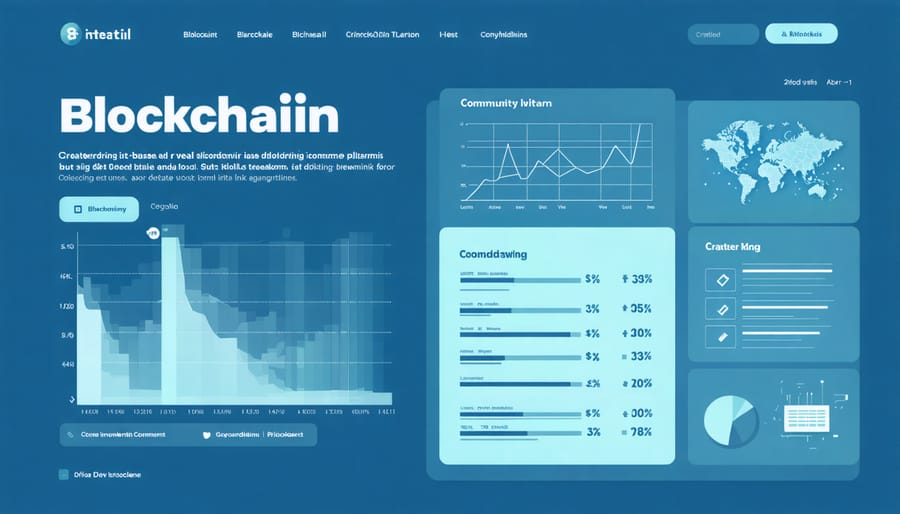Community real estate solutions are revolutionizing property ownership and development across America, creating unprecedented opportunities for both investors and residents. Traditional real estate financing models often exclude vital community stakeholders, but innovative collective ownership structures and community-driven development initiatives are changing this landscape dramatically. From community land trusts to cooperative housing developments, these alternative approaches combine social impact with sustainable financial returns.
By leveraging collective purchasing power and shared resources, communities are now accessing real estate opportunities previously reserved for large institutional investors. These solutions address critical challenges like affordable housing shortages, commercial property accessibility, and neighborhood preservation while generating sustainable returns for participants.
Local success stories demonstrate the viability of this approach: Cincinnati’s Over-the-Rhine Community Housing initiative preserved 500+ affordable units through community ownership, while Seattle’s Community Investment Trust enabled residents to invest in local commercial real estate for as little as $10 per month. These models prove that community-based real estate solutions can simultaneously serve social needs and create wealth-building opportunities for residents.
The future of real estate investment lies in these collaborative approaches that prioritize both community benefit and financial sustainability. Whether you’re a real estate professional, community organizer, or potential investor, understanding and implementing these solutions opens doors to previously untapped market opportunities.
How Community Real Estate Solutions Are Reshaping Property Finance

Crowdfunding and Community Investment Pools
Real estate crowdfunding and community investment pools represent innovative solutions for collective property ownership and development. These platforms enable community members to combine their financial resources, making previously unattainable real estate investments accessible to a broader range of investors.
Through these collaborative funding models, individuals can contribute amounts as small as $1,000 to participate in larger real estate ventures. The pooled resources are professionally managed, often through a legal entity such as an LLC or real estate investment trust (REIT), ensuring transparency and proper governance.
Community investment pools typically operate through either equity-based or debt-based structures. Equity-based pools offer participants ownership shares in the property, while debt-based pools function more like community mortgages, with investors receiving regular interest payments.
Success stories include neighborhood groups purchasing and renovating abandoned properties, converting them into affordable housing or community spaces. These initiatives not only provide financial returns but also contribute to neighborhood improvement and community building, creating a win-win situation for investors and residents alike.
Community Land Trusts
Community Land Trusts (CLTs) represent a innovative approach to preserving affordable housing through a unique shared ownership model. In this arrangement, a nonprofit organization maintains ownership of the land while residents own the buildings on it, effectively separating land costs from housing costs.
This model creates lasting affordability by implementing resale restrictions that keep home prices within reach for future buyers while allowing current homeowners to build modest equity. CLTs typically use a ground lease agreement that spans 99 years, providing long-term security for residents while ensuring the community maintains control over land use and development.
The effectiveness of CLTs in creating sustainable affordable housing has been demonstrated in cities across America. For example, the Champlain Housing Trust in Vermont, one of the country’s largest CLTs, has helped over 1,000 families achieve homeownership while maintaining affordability for subsequent buyers.
CLTs offer several advantages: they reduce initial purchase prices, protect against market speculation, and create permanently affordable housing stock. For communities facing gentrification pressures, CLTs serve as a powerful tool to preserve neighborhood character while ensuring long-term affordability for residents.
Successful Community Financing Models in Action
Urban Co-Housing Developments
Urban co-housing developments have emerged as innovative solutions to both housing affordability and community building challenges. Notable examples include the Eastern Village Cohousing in Silver Spring, Maryland, which successfully combined private ownership with shared spaces through a unique financing structure that blends traditional mortgages with community investment pools.
The project’s 56 units were financed through a combination of individual mortgages and a collective LLC structure, allowing residents to share ownership of common areas while maintaining private ownership of their units. This arrangement reduced individual costs by approximately 15-20% compared to traditional condominium developments in the area.
Another exemplary case is the Pioneer Valley Cohousing Community in Amherst, Massachusetts, which utilized a limited equity cooperative model. Here, residents purchase shares in the cooperative rather than individual units, making the development more affordable while ensuring long-term community stability. The financing structure included a combination of private loans, member equity investments, and creative lending partnerships with local credit unions.
The financial success of these projects often relies on early community involvement and careful structuring of ownership agreements. Many developments utilize a hybrid approach, combining traditional financing methods with innovative community-based funding solutions. This might include community development financial institution (CDFI) loans, member loans, or even crowdfunding components to complete the capital stack.
For aspiring co-housing communities, these examples demonstrate the importance of establishing clear financial frameworks that balance individual ownership rights with community benefits while maintaining long-term affordability.

Neighborhood Investment Cooperatives
Neighborhood Investment Cooperatives (NICs) are emerging as powerful tools for community-driven commercial real estate development. These locally-focused investment groups pool resources from community members to purchase, renovate, and manage commercial properties within their neighborhoods. Unlike traditional real estate investment approaches, NICs emphasize both financial returns and community benefits.
Members typically invest anywhere from $1,000 to $10,000, making property ownership accessible to a broader range of community stakeholders. This democratic approach to real estate investment allows residents to have a direct say in their neighborhood’s development while building wealth through property appreciation.
Success stories include the Northeast Investment Cooperative in Minneapolis, which has transformed vacant storefronts into thriving local businesses, and the East Bay Permanent Real Estate Cooperative in Oakland, which focuses on preserving affordable commercial spaces for local entrepreneurs.
Key benefits of NICs include:
– Local wealth creation through shared property ownership
– Prevention of commercial displacement
– Support for small business development
– Community-driven decision making
– Preservation of neighborhood character
To establish a NIC, communities typically need to navigate securities regulations, develop strong governance structures, and create clear investment terms. While the initial setup requires significant coordination, the model has proven effective in creating sustainable, community-controlled commercial spaces that serve local needs while generating returns for investor-members.
Implementation Strategies for Communities
Legal Framework and Structure
Community real estate solutions operate within a complex legal framework that requires careful consideration and proper structuring. The foundation typically begins with choosing an appropriate business entity, such as a Limited Liability Company (LLC), cooperative, or nonprofit organization, depending on the specific goals and needs of the community initiative.
For LLC structures, members enjoy personal liability protection while maintaining flexibility in management and profit distribution. Cooperatives, on the other hand, operate on a one-member-one-vote principle, making them ideal for community-focused projects where democratic decision-making is paramount. Nonprofit organizations can be particularly effective when the primary goal is community development rather than profit generation.
Understanding local zoning laws, property regulations, and securities laws is crucial, especially when implementing alternative real estate funding methods. Many community real estate projects must comply with both state and federal securities regulations, particularly when raising capital from multiple investors.
Legal documentation requirements typically include:
– Operating agreements or bylaws
– Membership or shareholder agreements
– Property management contracts
– Investment disclosure documents
– Regulatory compliance filings
It’s essential to work with experienced legal counsel familiar with community real estate structures to ensure proper documentation and compliance. This helps protect all stakeholders while creating a sustainable framework for long-term success. Regular legal audits and updates to organizational documents help maintain compliance and adapt to changing regulations or community needs.
Risk Management and Insurance
Effective risk management is crucial when developing community real estate solutions, requiring a comprehensive approach to protect both investments and stakeholders. Insurance plays a vital role in mitigating potential risks and securing long-term project success.
Community real estate initiatives should prioritize obtaining appropriate insurance coverage, including property insurance, liability protection, and specialized coverage for unique community features. Key insurance considerations include:
1. Commercial Property Insurance: Covers physical structures and common areas against damage from natural disasters, fire, and other hazards.
2. General Liability Insurance: Protects against third-party claims for bodily injury or property damage.
3. Directors and Officers (D&O) Insurance: Essential for community organizations and boards managing real estate projects.
4. Professional Liability Insurance: Important for service providers involved in community development.
Risk assessment should be conducted regularly, identifying potential threats such as:
– Market fluctuations affecting property values
– Environmental hazards
– Construction defects
– Community liability issues
– Legal and regulatory compliance risks
To minimize exposure, implement these risk management strategies:
– Regular property maintenance and inspections
– Clear documentation of all transactions and agreements
– Strong governance structures for community organizations
– Emergency response plans
– Professional property management services
Consider creating a risk management committee within your community organization to oversee insurance matters and risk mitigation efforts. This committee should review coverage annually, update policies as needed, and ensure compliance with local regulations.
Working with experienced insurance brokers who understand community real estate can help identify coverage gaps and secure appropriate protection at competitive rates. Remember that risk management is an ongoing process requiring regular review and adjustment as community needs evolve.
Future of Community Real Estate Finance
Technology Integration
The integration of technology has revolutionized how communities approach real estate solutions, with digital real estate platforms leading the transformation. These platforms now enable seamless collaboration between investors, homeowners, and community organizations, making participatory real estate investments more accessible than ever.
Mobile apps and web-based portals have become essential tools for managing community real estate projects. They facilitate everything from initial fundraising to ongoing property management, with features like automated payment processing, digital document signing, and real-time project updates. Blockchain technology is also making inroads, offering transparent record-keeping and simplified property transfer processes.
Cloud-based property management systems have streamlined operations for community real estate initiatives, allowing multiple stakeholders to access critical information simultaneously. These systems typically include features for maintenance scheduling, tenant communication, and financial reporting, making it easier to manage community-owned properties efficiently.
Virtual and augmented reality technologies are transforming property viewings and community planning. Potential investors and residents can now take virtual tours of properties and visualize proposed community developments before they’re built. Additionally, AI-powered analytics help communities make data-driven decisions about property investments and development strategies, ensuring more sustainable and profitable outcomes for all stakeholders.
Social media and communication platforms have also become vital tools for building and maintaining community engagement in real estate projects, facilitating ongoing dialogue and transparent decision-making processes.

Policy Changes and Opportunities
Recent policy shifts are creating new opportunities in community real estate finance. The Community Reinvestment Act (CRA) modernization, expected to take effect in 2024, will expand access to financial resources for neighborhood development projects. This update includes provisions for digital banking services and revised assessment criteria that could benefit local real estate initiatives.
States are also introducing legislation to support community land trusts and shared equity programs. For instance, several jurisdictions now offer tax incentives for properties held in community trust arrangements, making these models more financially viable for both developers and residents.
Opportunity Zones continue to evolve, with new Treasury guidelines providing clarity on investment requirements and benefits. These changes make it easier for community organizations to leverage tax advantages while developing affordable housing and mixed-use properties.
Of particular interest are emerging zoning reforms that support missing middle housing and accessory dwelling units (ADUs). These policy updates are creating opportunities for small-scale community investors and property owners to participate in neighborhood development while addressing housing affordability challenges.
Municipal governments are increasingly adopting inclusionary zoning policies, requiring developers to include affordable units in new projects. This trend is reshaping how community real estate projects are structured and financed, opening doors for innovative funding mechanisms like social impact bonds and community investment trusts.
Watch for upcoming federal housing policy changes that could further expand financing options for community-based real estate development.
Community real estate solutions represent a powerful shift in how we approach property ownership, investment, and development. By embracing these innovative approaches, we can create more inclusive, sustainable, and financially viable real estate opportunities for all stakeholders involved.
The key to success lies in understanding and implementing the various tools at our disposal. From community land trusts and housing cooperatives to crowdfunding platforms and peer-to-peer lending networks, each solution offers unique advantages that can be tailored to specific community needs and goals.
To get started, consider these essential action steps:
1. Assess your community’s specific real estate challenges and opportunities
2. Research and connect with existing community real estate organizations
3. Evaluate available financing options and funding mechanisms
4. Build partnerships with local stakeholders, including developers and financial institutions
5. Develop a clear implementation strategy with measurable goals
Remember that successful community real estate initiatives require ongoing commitment, clear communication, and strong partnerships. Stay informed about emerging trends and regulatory changes that might affect your chosen solutions. Consider working with experienced professionals who can guide you through the process and help navigate potential challenges.
By taking these steps and remaining committed to the principles of community-based real estate development, you can contribute to creating more resilient, equitable, and thriving neighborhoods while potentially securing attractive returns on investment.